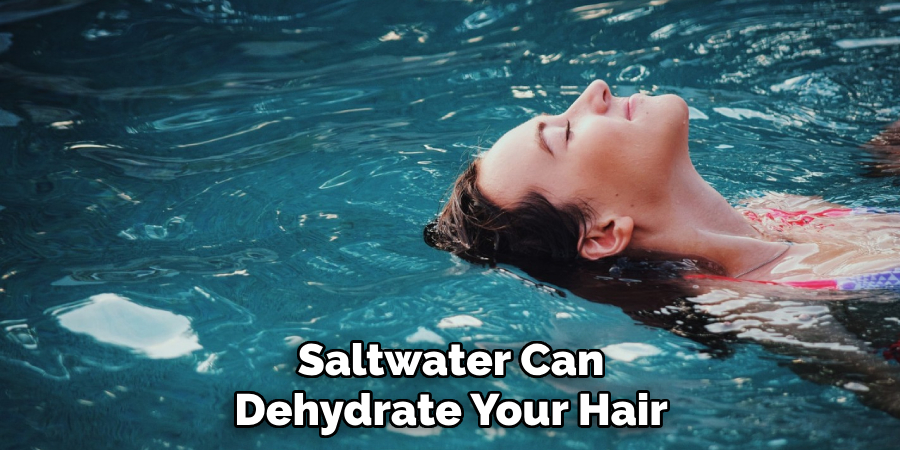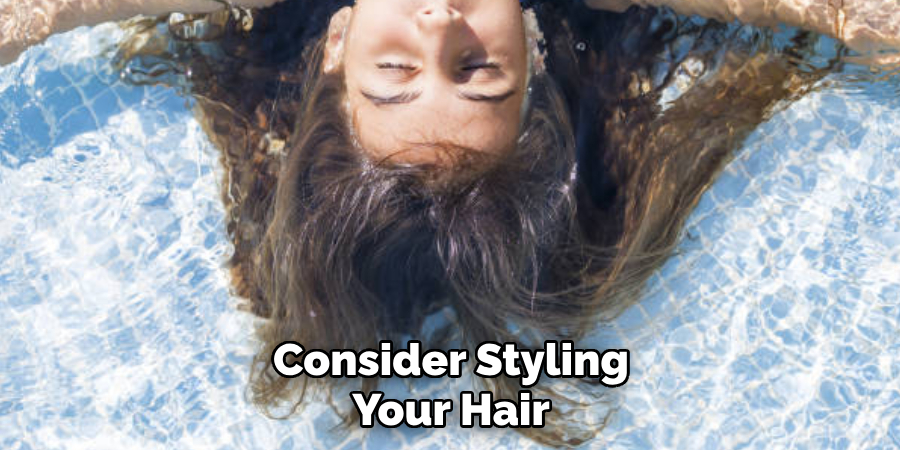Are you tired of dealing with dry, brittle hair after a swim? Whether taking a dip in the pool or enjoying a day at the beach, exposure to chlorine and salt water can damage your hair.

Swimming is a refreshing and enjoyable activity that provides numerous health benefits. However, exposure to chlorine, saltwater, and other harsh elements can take a toll on your hair, leaving it dry, brittle, and prone to damage. To keep your locks healthy and vibrant while indulging in the pool or ocean, it’s essential to take proactive steps to protect your hair.
In this guide on how to protect your hair when swimming, we will explore effective strategies and techniques to safeguard your hair from the harmful effects of swimming. Let’s dive in!
What Are the Causes of Hair Damage While Swimming?
To understand how to protect your hair when swimming, it’s crucial to know the factors that contribute to hair damage in the first place. Here are some of the most common causes:
- Chlorine: Although chlorine helps keep pools clean by killing harmful bacteria, it can also strip your hair of natural oils and moisture. This can lead to dryness, frizz, and even discoloration.
- Saltwater: Similarly, saltwater can dehydrate your hair and cause it to become brittle and prone to breakage. The high salt content in seawater can also cause color-treated hair to fade faster.
- Sun Exposure: UV rays from the sun can damage your hair’s protein and lead to dryness, split ends, and frizziness.
- Chemicals: Aside from chlorine, other chemicals commonly found in pools and hot tubs can also cause hair damage. These include algaecides, pH balancers, and clarifiers.
With these factors in mind, let’s explore how to protect your hair while swimming.

What Will You Need?
Before diving into the water, make sure you have these essential items on hand to protect your hair:
- Swim Cap: A swim cap is a must-have for serious swimmers. It creates a barrier between your hair and the pool water, preventing chemicals and other substances from penetrating your strands.
- Leave-In Conditioner: Applying a leave-in conditioner before swimming can help create extra protection for your hair. Look for products that contain UV filters to shield against sun damage.
- Hair Oil or Serum: If you have long hair, consider applying oil or serum to the tips of your hair before swimming. This will help seal in moisture and protect against split ends and frizz.
- Wide-Tooth Comb: After swimming, use a wide-tooth comb to gently detangle your hair and remove any chlorine or saltwater residues. This will prevent breakage and minimize damage.
9 Easy Steps on How to Protect Your Hair When Swimming
Step 1: Wet Your Hair
Wet your hair thoroughly with clean water before diving into the pool or ocean. Wetting your hair before swimming helps to limit the amount of chlorine or saltwater your hair can absorb. By saturating your hair with fresh water, it creates a protective barrier, reducing the absorption of chemicals and minimizing the potential damage to your hair strands.
Additionally, wetting your hair helps to prevent it from becoming dehydrated, as dry hair is more susceptible to damage from chlorine or saltwater. Take a moment to run water through your hair in the shower or use a spray bottle to dampen it evenly from roots to ends. Once your hair is wet, you’re ready to take the plunge and confidently enjoy your swim!
Step 2: Apply a Leave-In Conditioner
After wetting your hair, apply a leave-in conditioner throughout your strands. Look for products specifically designed for swimmers that contain UV filters and other protective ingredients. Work the product through your hair using a wide-tooth comb to ensure even distribution. This will provide an extra layer of protection and help keep your locks moisturized and healthy.
Step 3: Consider Using Protective Hair Oil or Serum
If you have long hair, consider applying oil or serum to the tips of your hair before swimming. These products can help seal in moisture and protect against split ends, frizz, and damage from chlorine or saltwater. Choose lightweight oils such as argan or coconut, which won’t weigh your hair down.

Step 4: Put On a Swim Cap
Swim caps are essential for protecting hair while swimming. They create a barrier that prevents chemicals and other substances from penetrating your strands.
Additionally, swim caps can help keep your hair out of the way and reduce drag while swimming, making it easier to move through the water. Look for silicone or latex swim caps; these materials provide a more secure fit and better protection against chlorine and saltwater.
Step 5: Rinse Hair Immediately After Swimming
After you’re done swimming, it’s important to rinse your hair as soon as possible to remove any residual chlorine or saltwater. These substances can dry and damage your hair if left to sit. Rinse your hair thoroughly with fresh water to help restore its natural balance and remove any chemicals or impurities.
It’s recommended to use a gentle shampoo and conditioner specifically formulated for swimmers to cleanse further and nourish your hair. By rinsing promptly, you can help minimize potential damage and keep your locks healthy and vibrant.
Step 6: Protect Your Hair from the Sun
When spending time in the sun, it’s essential to protect your hair from harmful UV rays like you protect your skin. Prolonged sun exposure can lead to dryness, color fading, and brittleness. Here’s how you can safeguard your hair from the sun:
- Wear a Hat: Opt for a wide-brimmed hat or a cap to shield your hair and scalp from direct sunlight.
- Apply UV Protection: Use hair products that contain UV filters to create a barrier against the sun’s harmful rays.
- Avoid Peak Sun Hours: Whenever possible, limit your exposure during the peak hours of 10 am to 4 pm when the sun’s rays are strongest.
- Seek Shade: Take breaks in shaded areas to give your hair a break from the sun’s intensity.
- Use Leave-in Conditioner: Apply a leave-in conditioner with sunscreen properties to protect and nourish your hair throughout the day.

Step 7: Use a Wide-Tooth Comb
After swimming, use a wide-tooth comb to gently detangle and remove chlorine or saltwater residues from your hair. This will help prevent breakage and minimize damage. Start at the ends of your hair and work your way up to the roots, being gentle and patient.
Step 8: Deep Condition Regularly
To replenish moisture and repair any damage caused by chlorine or salt water exposure, make deep conditioning treatments a regular part of your hair care routine. These treatments help restore hydration and nourishment to your hair, keeping it healthy and strong. Ensure you use a product specifically formulated for swimmers to target potential damage.
Step 9: Limit Hair Washes
Frequent hair washing can strip away the natural oils that provide moisture and protection to your hair. To maintain the health and integrity of your hair, it’s important to limit the number of times you wash it, especially after swimming.
Overwashing can lead to dryness and damage, especially if using harsh shampoos containing sulfates. Instead, consider these tips to keep your hair fresh and clean in between washes:
- Dry Shampoo: Use a dry shampoo between washes to absorb excess oil and refresh your hair. This can help extend the time between washes while keeping your hair looking and feeling clean.
- Rinse with Water: If you need to rinse your hair after swimming, opt for a simple water rinse instead of shampoo. This will help remove any impurities without stripping away the natural oils.
- Use a Silk or Satin Pillowcase: Sleeping on a silk or satin pillowcase can help minimize frizz and prevent moisture loss while you sleep. These materials provide a smooth surface for your hair to glide on, reducing friction and breakage.
- Protective Hairstyles: Consider styling your hair in protective hairstyles, such as braids or buns, to minimize exposure to environmental elements and reduce the need for frequent washing.
- Invest in High-Quality Hair Products: Choose hair products that are gentle, sulfate-free, and formulated for your hair type. This can help maintain the health of your hair and minimize the need for excessive washing.
By following these steps and incorporating them into your haircare routine, you can keep your locks looking healthy and strong while enjoying all the benefits of swimming.

Conclusion
Swimming is a fun and invigorating activity that provides many health benefits, but it’s important to take care of your hair while doing so.
By following these steps, you can protect your hair from the damaging effects of chlorine and saltwater, maintain its moisture and health, and keep it looking beautiful. Remember to invest in high-quality hair products, rinse after swimming, limit washing, use protective hairstyles, and apply UV protection for optimal haircare results.
Hopefully, the article on how to protect your hair when swimming has been helpful and informative. Enjoy your time in the water without worrying about your hair! So go ahead and make a splash with healthy and protected locks! Happy swimming!
About the Author
Jane Hubbard is a passionate beauty expert with a wealth of experience in makeup, hair, and overall beauty techniques. After years of working as a hairdresser specialist, she followed her entrepreneurial spirit and started her own consultancy business.
Jane has always been driven by her desire to help others feel confident in their own skin, and she does this by sharing her knowledge, experiences, and practical beauty tips. Through her consultancy, she empowers individuals to embrace their unique beauty, offering tailored guidance that boosts both self-esteem and personal style.
Professional Focus
- Specializes in makeup, hairstyling, and beauty consulting.
- Provides personalized beauty advice, tips, and techniques to help individuals feel confident in their appearance.
- Dedicated to staying up-to-date with the latest industry trends and developments.
- Passionate about creating a comfortable and empowering experience for every client.
Education History
- University of Craft and Design – Bachelor of Fine Arts (BFA) in Woodworking and Furniture Design
- Woodworking Apprenticeships – Extensive hands-on training with skilled craftsmen to refine carpentry and furniture making techniques
- Online Courses & Masterclasses – Continued education in advanced woodworking techniques, design principles, and specialized tools
Expertise:
- Makeup artistry, hairstyling, and beauty consulting.
- Personalized beauty techniques to enhance confidence and self-expression.
- Educating clients on how to maintain their beauty routines at home.
